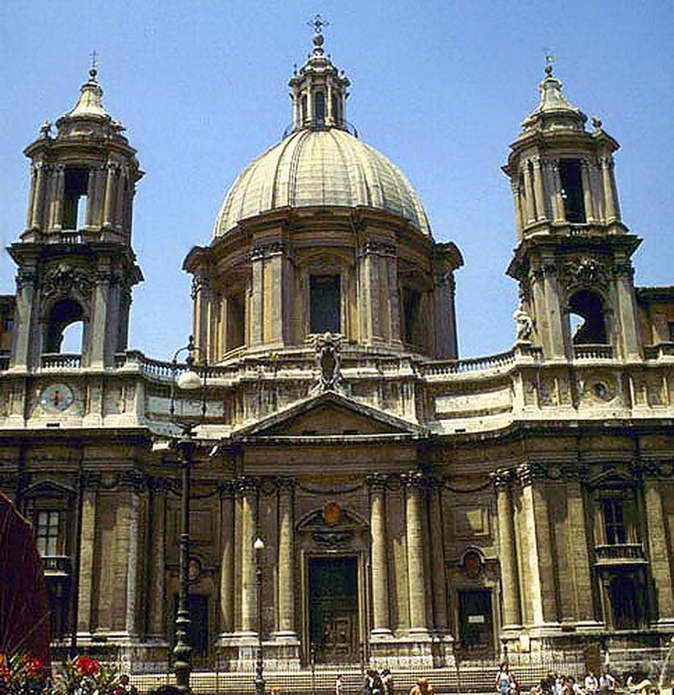Baroque features. Baroque - architectural style
The main features of the Baroque
The main features of the Baroque are considered to be increased and emphasized monumentality, representativeness, which to some extent were self-sufficient qualities and were often achieved by artificial means. In an effort to create the impression of monumentality, representativeness, picturesqueness, dynamics of forms, to evoke a feeling of unusualness and surprise in the perception of architecture, architects proceed primarily from the external plastic appearance of buildings (meaning both the exterior and the interior).
Baroque noted:
The complexity of volumes and space, mutual intersection various geometric shapes,
- the predominance of complex curvilinear forms in determining the plans and facades of structures,
- alternation of convex and concave lines and planes
- active use of sculptural and architectural and decorative motifs;
- uneven distribution of architectural means;
- creating a rich play of chiaroscuro, color contrasts
- dynamism of architectural masses.
The rationality of the Renaissance is replaced by irrationality. Baroque architects clearly prefer the decorative principle of architecture. Baroque in architecture is characterized by priority, the predominance of the plastic principle over the tectonic principle. In an effort to create an unusual, heightened emotional architectural effect, they often neglected the logic of building plans, allowed inconsistencies between the external volumes and the internal structure of the structure. The design in the creative mind of architects in most cases, as it were, is relegated to the background, being a necessary, but still an auxiliary means designed to “provide”, maintain one or another plastic form. The design is usually covered with decorative parts, which often create a misleading impression of it. Facades are intended to "shield" the main part of the building. Orders are considered only as elements decorating structures. In the architecture of this time, obviously deconstructive parts - torn ones: pediments, volutes, etc., become widespread.
The illusion of the movement of space and form, the so-called dynamic principle, is the main feature radical trends in the baroque. At the same time, Baroque is also developing greatly. classical directions. The classical direction comes from the traditions of the Renaissance, the ideas of which are developed theoretically and practically. Despite the differences, both directions are united in their desire to create vast spaces that have a strong impact on human feelings and emotions. During the 17th and 18th centuries both directions exist in parallel, with some predominance of one or the other in individual countries.
In the defining structures of the 17th - first half of the 18th centuries special development and diversity acquire monumental sculpture and monumental painting, as well as different kinds applied arts. In painting and sculpture, decorative origins take over, multifaceted compositions with features of strongly pronounced dynamics, with complicated generalizing lines and rhythms predominate. When depicting a person, states of tension, exaltation, and increased drama are preferred. The synthesis of arts in the Baroque had a different character than before, in the Renaissance. In the architecture of the Renaissance, certain places were allocated for works of painting and sculpture - part of the wall, ceiling, etc. Works of art, limited to the area allotted to them, harmonized with architecture, complementing and enriching it. In Baroque buildings, painting and sculpture "do not fit" within certain limits, they go beyond them, do not obey architecture and tend to "shout" it, as it were. There was not peaceful cooperation, but a dispute, struggle and opposition to each other certain types arts.
Baroque church of Sant'Agnese in Agone (1653-1661). Created in honor of the early Christian martyr St. Agnes of Rome in Rome. Initially, the church was built by Rainaldi, then it was completed by Borromini. Navona Square. Rome.
Baroque architecture, for a long time not perceived by fans of classical forms, as an independent and self-sufficient style, appeared at the turn of the late Renaissance, as its continuation and development. To some extent, this was a return to philosophy, since the style reflected the ideology of Catholicism: the expressiveness, mysticism, illusory nature inherent in the Baroque are also characteristic of the Catholic worldview. Thus, we can say that the baroque arose when the philosophy of ancient art merged with the mentality of the Catholic clergy. One of the stylistic currents of the Italian Baroque was called the “Jesuit style”, or “Trentino”. The founder of this trend was a member of the Jesuit order A. Pozzo, the author of the painting "Apotheosis", depicting the ascension of Ignatius Loyola - the head of the Jesuit order - on the ceiling of the church of St. Ignatius in Rome (1684). A. Pozzo was an architect, painter, sculptor. The ideas of ascension, soaring, incorporeality were realized by artists who decorate the ceilings and walls of temples. The murals seemed to break through the plane of the walls or ceiling, not taking into account the design features of the architecture. The architecture of this period becomes very picturesque and rich in artistic details. Illusory constructions were created through various techniques: painted architectural elements created an almost imperceptible transition from a real construction to a fictional one, which visually changed the space.

The main artistic idea of baroque architecture is the psychological impact on a person, his subordination to the dynamics and activity of style, a high degree of emotionality. Masters were looking for beauty not in nature, but in their imagination, relying on ancient traditions. In addition to beauty, baroque demanded from works of art, including architecture, grace, grace, as well as compliance with such concepts as “cortesia”, which means “warmth”, “tenderness” - the architects conveyed these qualities to their buildings using the plasticity of forms and surfaces . The main features of the Baroque in architecture are the scale of architectural details that are incomparable with human proportions. In the classics, all forms are proportional, separated from each other, proportionate to the viewer, have clear contours. The norm in the Baroque was the size of windows, doors, portals tens of times greater than human height. Another feature of the Baroque in architecture is the repeated repetition of the same details and decorative techniques in the facade of one building. I. Grabar (Russian artist, art critic, museum worker. 1871-1960) wrote about the Italian architecture of the Baroque era: “Neurasthenic enthusiasm doubles and triples all means of expression: there are already few individual columns, and where possible, they are replaced by pairs; one pediment seems insufficiently expressive, and they are not embarrassed to tear it apart in order to repeat another, smaller scale in it. In pursuit of a picturesque play of light, the architect does not immediately reveal all the forms to the viewer, but presents them gradually, repeating them two, three and five times. The eye gets confused and lost in these intoxicating waves of forms and perceives such complex system rising and falling, leaving and approaching, now underlined, now lost lines, that you do not know which of them is true? Hence the impression of some kind of movement, a continuous run of lines and a flow of forms. Repeated repetition created a complex system of using architectural elements: groups of pilasters appeared, half-pilasters were added on the sides of the pilasters, the intervals between the pilasters were framed by flat frames. Such features of the Baroque in architecture became the antipode of the Renaissance idea of harmony. Baroque architecture (photo below), refers to early period: architectural elements are repeated many times in the building, thanks to the protruding semi-columns - single and double, the effect of light and shade is enhanced, which gives the building dynamism.

Earlier Baroque. The Lateran Palace (Palazzo del Laterano) was built by order of Pope Sixtus V in 1586 according to the design of Domenic Fontana.

Facade of the Church of Il Gesu p (1575-1584). Vignola project. Architect Giacomo della Porta.
The facade became a decoration, and the interior space could take on unexpected dimensions for the viewer thanks to the creation of illusions of light and shadow, drawings and paintings. The main thing is the effect of unexpectedness of impression and suddenness. The geometric figures involved in the formation of buildings lose their stationarity - an oval is used instead of a circle, a rectangle becomes a replacement for a square. If in the Renaissance, calculations were based on the ratio of prime numbers, then, as before in Gothic, in the architecture of the Baroque era, the triangulation system began to be used (a method for calculating proportions based on an equilateral or isosceles triangle, which was considered a symbol of "Divine Harmony"). Plans of buildings were created in the form of geometric shapes: triangles, pentagrams, stars, ovals, which gave the facades and interiors of buildings dynamism. An example of Baroque architecture in the photo below: the plan of the Church of San Ivo ("Jesuit style") by the architect F. Borromini is a "Star of David" - two intersected equilateral triangles.
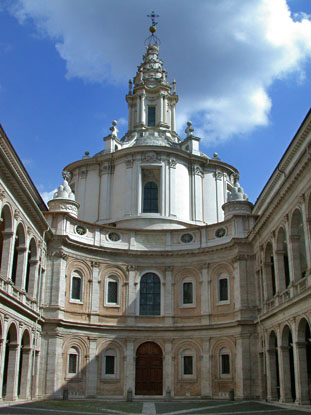
The visual functionality of baroque structures does not always correspond to reality. Real tectonics means that visual perception corresponds to the construction of the building, and imaginary tectonics, antitectonics, on the contrary, creates illusory images. Tectonics is designed to show that the structure is reliable, stable, capable of creating reliable protection for a person, sheltering him from adversity and at the same time not “pressing down” the weight of walls or other architectural elements. Baroque architecture created anti-tectonic structures, which instead of stability and rigidity give a sense of instability; instead of stationarity - movement and transformation.
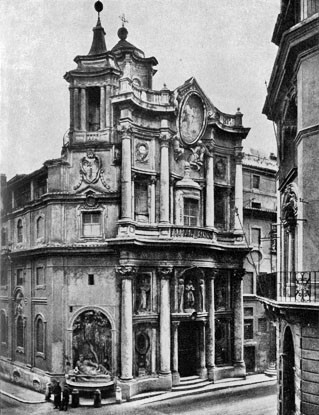
The facade of the Church of San Carlo "At the Four Fountains" in Rome (1638-1667) Borromini created a combination of convex and concave volumes.
Another feature of Baroque architecture is the so-called “fear of emptiness”, when the facade is filled with an abundance of details that hide the structure. Clear boundaries, the isolation of architectural elements and decor, characteristic of the Renaissance, are replaced by plasticity, the flow of forms, which leads to the disappearance of a clear outline of structures. In the Baroque, a broken rhythm was often used in decoration, the technique of “going beyond the frame”, the style is characterized by a play of volumes, light and shadow. Baroque architects created walls with dynamic forms: they could converge under acute angle, creating the feeling of a knife cutting the street into pieces, be concave or convex. An example of baroque architecture in the photo below:
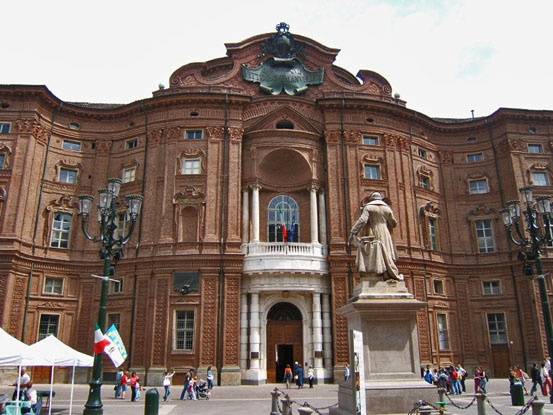
Palazzo Carignano (Palazzo Carignano, 1679) The project of the architect Guarini. The brickwork façade of the building overlooking Piazza Carignano was created in the Baroque style of the 17th century. It has a concave-convex shape.
Among the architectural techniques of the Baroque: the installation of columns in groups, beams, moved away from the walls or opposite, as if "drowned" in the walls, which created the effect of protruding or receding surfaces. Sculptural compositions, abundantly decorating the architecture of the Baroque era, intensified the feeling of blurring of boundaries, the fragility of the walls, which cease to seem like reliable supports separating the inner space from the outside world. A feature of Baroque architecture is gigantism. They tried to increase the decor, make it monumental. Volutes - decorative curls - become huge (for example, on the facade of the Il Gesu church in Rome). An example of gigantism is the work of the architect Bernini (Jean Lorenzo Bernini (1598-1680). The kivorium tent (29 m high) he created in St. Peter's Cathedral stuns the viewer with its scale, disproportionate to the size human body. Towards the center of the cathedral, the interiors of which are decorated by Bernini, the space seems to grow, the dome moves up to a dizzying height, huge statues hang, which puts pressure on the viewer who comes here, creates a feeling of human insignificance, worthlessness against the grandeur of the building. Stendhal wrote at the beginning of the 19th century: "If a foreigner, having come to St. Peter's Cathedral, decides to inspect everything, he will have a severe headache."
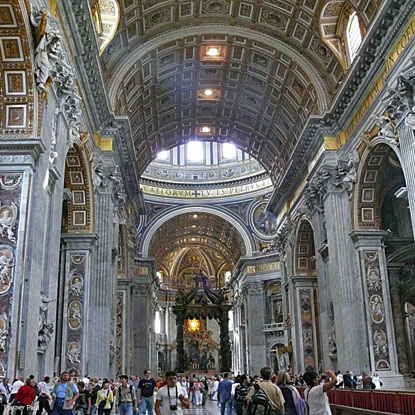
The interior of St. Peter's Basilica in Rome reflects the disproportionate scale of architectural elements and decor with the size of the human body.
baroque architects
Each architect sought to convey his own worldview through his creations. The characteristic features of Bernini's work are deliberateness, gigantism, theatricality, props. For example, in Rome, in front of St. Peter's Basilica, Bernini built a colonnade that hides the chaotic urban development located behind it, and formed the imaginary space of the square. He created squares with monuments and fountains, facades - scenery covering buildings. Bernini was a master of illusion and dematerialization, using a variety of methods for this, combining different materials and coloring methods in one composition, conveying a feeling of lightness, movement through the air even to large and heavy fragments of decor. A follower of Bernini's work, C. Rainaldi, built in Rome. B. Longena worked in Venice, who created the church of Santa Marna della Salute (1631-1682). The Bolognese S. Serlio, a follower of mannerism, created the basis for the methods of violating traditional proportions in construction, for example, to create in the viewer a feeling of pressure on the building, its heaviness , proposed to make each next floor a quarter lower than the previous one. Mathematician, professor of philosophy, architect G. Guarini in baroque architecture combined different architectural forms and dimensions in one structure, as in the photo below:
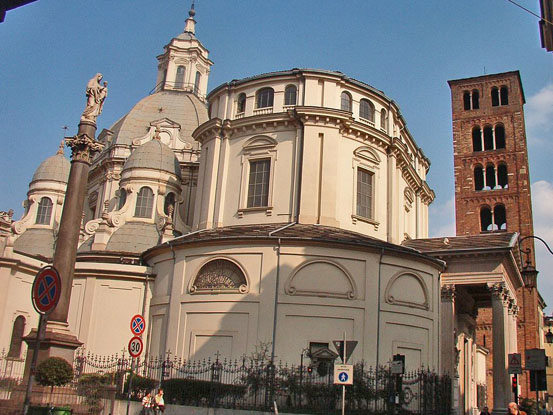
Temple of Santuario della Consolata (Santuario della Consolata Temple of Consolata - Our Lady of the Comforter, from 1679) Architect G. Guarini.
Baroque decor
The decor in the architecture of the Baroque era is characterized by a combination of images of characters from different periods and religions: mythological, biblical, New Testament heroes and allegorical figures, as well as symbolic signs and attributes. In the same ensemble, the sculpture of the Madonna and the statue of Aphrodite could be next to each other, in the same composition Christ and Jupiter turned out to be. The Catholic cross was adjacent to the trident of Neptune, and the chariot of the sun god became the symbol of the Ascension. Pagan gods got along with the images of the project's customers, as well as with Catholic saints. So the baroque masters emphasized the fantastic nature of their works, and the church, although it protested against such mixtures, was nevertheless forced to come to terms with these features of style. In 1644, Innocent X ordered the erection of an Egyptian obelisk, brought to Rome by the emperor Caracalla. Bernini created a project for an unusual fountain, placing around the Egyptian obelisk the figures of the river gods of the most famous rivers - the Nile, Ganges, Danube, La Plata.
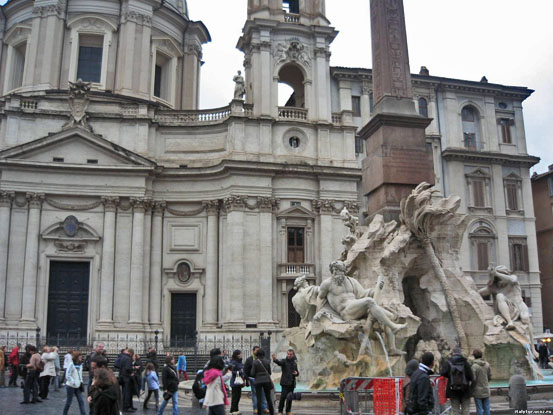
Lorenzo Giovanni Bernini. Fountain of the Four Rivers in Piazza Navona, Rome. (Fontana dei Quattro Fiumi) 1648-1651
Baroque architecture strikes with a combination of sublimity and exaltation with excessive theatricality. Baroque is a style of extremes, contrasts, illusions, which is why for a long time it was not recognized among fans of clear, strict and clear forms of antiquity, who considered baroque to be a sign of bad taste and vulgarity.
As promised, I continue the series of posts dedicated to style BAROQUE .
This time it's about characteristic features baroque architecture , thanks to which this style has become so recognizable that it is almost impossible to confuse it with any other architectural style.
In baroque architecture, everything was designed to give the impression of lush wealth, theatrical spectacle, solemn splendor, to stop the gaze of a passer-by, struck by the external appearance of the structure, or a visitor to a baroque building, stunned by the luxury of its interiors.
Embassy staircase in the Winter Palace of St. Petersburg (1754 - 1762)
F. B. Rastrelli
Art critic I. E. Grabar very accurately noticed the features of the perception of works of baroque architecture:
"In pursuit of a picturesque play of light, the architect does not reveal to the viewer all the forms at once, but presents them gradually, repeating them two, three and five times. The eye gets confused and lost in these intoxicating waves of forms and perceives such a complex system of rising, falling, leaving and impending, now underlined, now lost lines, that you don’t know which of them is true? Hence the impression of some kind of movement, a continuous run of lines and a stream of forms.
Highlight character traits baroque architecture is not that difficult as they are quite obvious.
So in my opinion The main features of Baroque architecture are:
1. Gravitation towards large urban and landscape gardening ensembles, where architecture, sculpture and painting merge into one.
Vienna, Schönbrunn
2. Scaling up, massiveness, distortion of classical proportions, when order elements cease to be proportionate to a person.
3. The appearance of a solid and unified facade, which becomes a kind of decoration of the building, designed for the effect of perspective reduction. This is exactly what I don’t like most about iconic baroque buildings, when a magnificent and solemn facade hides the unpresentability (if not more - wretchedness) of the building itself.
4. Creating a deliberately curved, almost illusory space due to the fluidity of curvilinear shapes and volumes(an oval in plans and details, an ellipse instead of a circle, a rectangle instead of a square, etc.).
5. Strengthening the decorative beginning, detailing, illusory disappearance of walls in the mass of decorations, sculptures, mirrors, windows ("fear of emptiness"); the use of rich colors and gilding, the creation of optical visual effects due to the refraction and reflection of sun glare, side lighting, the contrasting alternation of illuminated and shaded areas.
AT different countries Europe, the formation and flourishing of the Baroque in architecture had their own characteristics.
in Italy new style declared itself already at the end of the 16th - beginning of the 17th century. In Belgium, Austria and southern Germany - in the 18th century, and in Russia - closer to the middle of the 18th century. But how!!!
Holland, the countries of Scandinavia, northern Germany remained indifferent to the magnificent baroque, which is most likely due to the Protestant ethic (anyone who has ever visited a Lutheran church at least once will understand what I mean).
In France, the baroque was present primarily in the interior decoration of architectural structures. In England, this style manifested itself in a mixed form, with numerous elements of Gothic, Rococo and Classicism. And in Spain and Portugal, which is explained by the peculiarities historical development these countries, the Baroque miraculously merged into the Gothic and Moorish styles.
Thank you for attention.
Sergei Vorobyov.
Ticket 21
Baroque architecture and sculpture. The work of Gian Lorenzo Bernini.
The main features of the Baroque.
Baroque is a style in art, architecture, literature that originated in Italy.
Baroque combines two concepts: lifestyle and style. The main features of the Baroque are pomp and flamboyance, grandiosity and solemnity, luxury and magnificence.
This style is characterized by dynamics, intensity of feelings, tension and contrast, it combines reality with fantasy. Baroque inspired sensual-physical enjoyment of life.
Baroque style main features
The main features of the Baroque, perhaps, are dynamic forms and curved lines. It is characterized by contrasts of rhythms and scales, light and shadow, materials and textures. This style shows a passion for allegories, similitudes, complex metaphors and other expressive art forms.
Baroque architecture loses its harmonious balance, and the circle becomes an oval, the square becomes a rectangle, the centric is replaced by an extended one. Instead of balanced proportions, complex constructions and a variety of forms appear. At the same time, axes and symmetry dominate in Baroque architecture.
In the Baroque, a person appears as a multifaceted personality with a rich and complex inner world and dramatic experiences. Baroque art is characterized by the realism with which the person is depicted. Conflict, tension and movement abound in the Baroque. A striking example is the sculpture "The Rape of Proserpina" by Bernini.
It is a highly ornamental style with a strong harmonic basis.
It was distinguished by expressiveness, an abundance of decor, pomp and excess in everything. Painting, sculpture, architecture were combined into new spatial relationships, both real and illusory.
The baroque style has the following characteristic features:
Main themes - mythology and religion
The lexicon has been enriched with colloquial and foreign words
Use of complex metaphors and epithets
Visible dynamics
Use of contrasts
Variety of genres
Architectural structures are different from each other and have individual style
Lots of jewelry and golden elements
The viewer must be amazed, surprised and enlightened by the work of art
Everything must be huge and magnificent
Almost no straight lines
An abundance of curved lines, rounded and wavy shapes
Monumentality
allegories
Oppositions
Emotionality and sensuality
Search for a person in the world, questions of being
Complex syntax
Unusual and unique
Acting and theatricality
The emergence of the Baroque:
baroque architecture - a period in the development of architecture in Europe and America (especially in Central and South), covering approximately 150-200 years. The period began at the end of the 16th century and ended at the end of the 18th. Baroque (as a style) embraced all art forms, but was most clearly reflected in painting, theater (and related literature, music) and architecture.
Brief description of the architectural style of the Baroque:
Characteristic features: symmetry in the style of space. Lots of stucco. The complex surfaces of the plane in the buildings are large and new in the columns, the frenziedly finished ceilings with recessed parts.
Predominant colors: muted pastel colors; red pink white blue with yellow accent.
Lines: bizarre convex-concave asymmetric pattern; in the forms of a semicircle, a rectangle, an oval; vertical lines of columns; pronounced horizontal division.
Shape: vaulted domed and rectangular; towers balconies bay windows.
Interior elements: striving for grandeur and splendor; massive front stairs; columns pilasters sculptures stucco and painting carved ornament; relationship of design elements.
Designs: contrasting tense dynamic; pretentious on the facade and at the same time massive and stable.
Windows: semicircular and rectangular; with floral decoration around the perimeter.
Doors: arched openings with columns; vegetable decor.
From Baroque Mannerism, art inherited dynamism and deep emotionality, and from the Renaissance - solidity and splendor: the features of both styles harmoniously merged into one single whole. Baroque , gravitating towards the solemn "grand style", at the same time reflected progressive ideas about the complexity, diversity, and variability of the world.
Baroque is characterized by contrast, tension, dynamic images, affectation, striving for grandeur and pomp, for combining reality and illusion, for the fusion of arts (urban and palace and park ensembles, opera, cult music, oratorio); at the same time - a tendency towards autonomy of individual genres. Baroque architecture served to affirm the ideas of Catholicism and absolutism, but it reflected the progressive trends in architecture, which were revealed in the planning of cities, squares, buildings, designed for the masses of the people.
It is characteristic that in the Baroque era, the facades of Romanesque churches were remade into Baroque ones, since they seemed insufficiently expressive, while the Gothic ones remained intact. In many European cities, ancient cathedrals have towers with a new baroque finish and the same baroque portals, in the interiors - baroque altars. Both Gothic and Baroque are united by expression, an irrational understanding of architectural space.
Baroque masters:
Borromini (1599-1667), Yuvara, Domenico Fontana (1543-1607), Francesco Caratti (? −1675), Santino Solari, M. G. Zemtsov, V. V. Rastrelli, D. V. Ukhtomsky and others.
Examples:

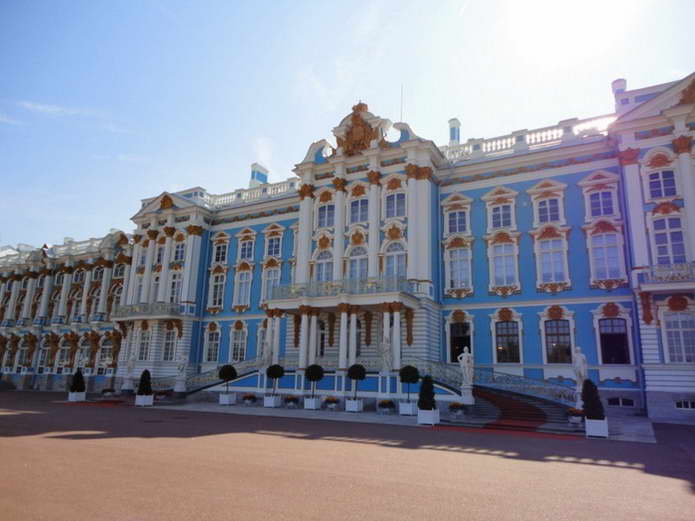
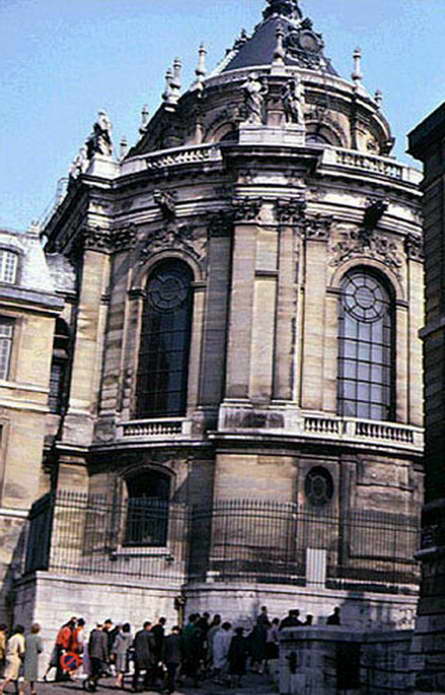


Church of Pope Clement, architect Pietro-Antonio Trezzini, Zamoskvorechye, Russia.
